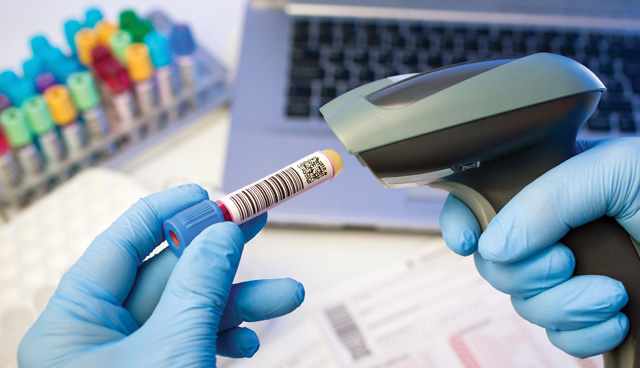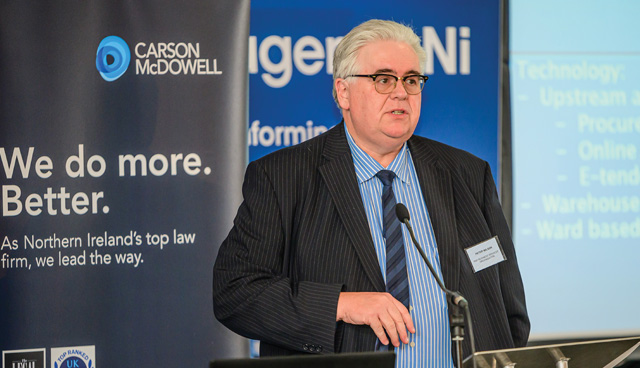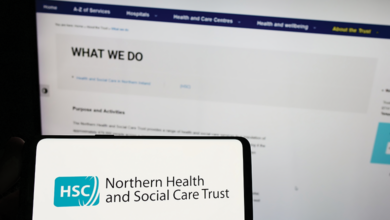Procuring innovation in health

Peter Wilson, Assistant Director of Procurement and Logistics in Business Services Organisation discusses how procurement is enabling innovation and change within health.
Operating as one of Business Services Organisation’s (BSO) shared services units, Procurement and Logistics Service (PaLS), with its own discrete budget, influences close to £800 million of spend a year – a figure soon to rise to around £1.3 billion following regulation changes in 2015.
PaLS is responsible for handling around 2.7 million transactions annually and has an operating budget of £14.4 million. It is within this context that Peter Wilson sets out the ability of procurement to enable innovation and change within health care delivery.
Wilson highlights an understanding that in order to influence change and innovation outside of the business unit, the initial focus had to be internal. “I think for procurement to be valued as a service that provides innovation, you have to move from being a gatekeeper to being a guru,” he states.
While he admits that PaLS has not yet reached the height of guru status, the unit has adopted recognition of those functions which are critical to procurement being viewed as a vehicle to deliver innovation and change. “Innovating, informing, empowering, enriching and enabling should be what we want our service to be,” he adds.
“To achieve this, we needed to firstly examine our own services to ensure we are being innovative in what we do and how we do it. Excellent service will ensure we build trust, credibility, an understanding of customer needs, collaboration and earn respect from those that we look after.”
Wilson takes the opportunity to highlight that underpinning PaLS’ procurement role is the understanding that they deliver healthcare and assist in making people better.
With an inward focus on developing services that complement procurement and add value, Wilson outlines some of the measures taken by PaLS such as the introduction of Ward Inventory Management, a programme that is estimated to have returned around £750,000 worth of time back to nurses through PaLS-managed high density storage. Another innovation has come in the form of procure to pay solutions such as online catalogues and cloud invoicing which has shifted some 80 per cent of manual transactions to digital.
Digital capability has played a big role in change, as highlighted by Wilson. In striving for a paperless office, PaLS are now using tools such as eTendersNI for online evaluation, which he says is providing consistency across Centres of Procurement Expertise and has enabled the release of more time to clients when involved in evaluations.
“We have also used technology to improve our supply chain management through vendor managed inventory within the system, either on site or offsite,” he adds.
Wilson turns to some of the projects PaLS has been involved with in recent years in procuring innovation. Underpinning various projects is an involvement with the Partnering with Small Business Research Initiative (SBRI).
“We have played an active part in running competitions for SBRI and helping BSO’s team to create transparency and develop products and solving problems that, in many instances, we didn’t know that we had.”
Completed projects to date include Medicines Optimisation, addressing poor adherence to medication and HOME, a project aimed at helping the elderly manage their medication at home.
Wilson describes such projects as “challenges that don’t have an automatic solution”. “That’s what SBRI is there to do,” he adds.
More recently, PaLS are partnered with SBRI in delivering more technology-enabled solutions such as PAIN, a digital platform to support patients managing chronic pain and CHAT, the re-engineering of care pathways using technology solutions.
Another aspect of innovation that PaLS has got involved in is that of pre-commercial procurement, which Wilson says is about bringing “rigour and transparency” to procuring innovation. A bid supported by PaLS around the MAGIC programme – exploring various options around how recovery from stroke could be improved – was the first successful recipient of funding from Horizon 2020 for a pre-commercial procurement project.
On PaLS’ ability to influence change, Wilson points to the Automated Laboratory Medicines System. In 2006, when moving to a category management system, PaLS brought together all of the heads of laboratories (then 17 Trusts) across the region to discuss procurement. The conversation naturally moved to practice and Wilson describes a scenario where questions were raised around existing differences.
“We offered a solution around the standardisation and procurement of laboratory equipment and consumables at a regional level. Those involved liked the idea and recognised wider opportunities,” explains Wilson.
“People tend to adapt and live with what they have rather than identify a problem that needs a solution … We need to change that mindset amongst clinicians and nurses where it is not already there.”
The standardisation of a range of laboratory specialisms in and around 2009 brought with it process, product and quality assurance and, as Wilson outlines, also meant that interchange was now possible.
“In standardising we built in contingency and protection which meant that if a system went down in one trust area, tests could still be conducted in another. Spinning out from that came a pathology review and the creation of a pathology network. We have expanded the number of specialisms involved and it’s been recognised as a really successful use of procurement to enable change.”
Turning to the challenges facing progress, Wilson outlines his belief that while an enhanced focus on compliance is welcome, to some extent it has stifled “ability or will” to take risks. “I think we need to think very hard about how we change that going forward,” he states.
One way of doing this, he suggests, is around co-design and making better use of pre-tendering engagement to deal with “that mindset of risk aversion”.
Finally, he recognises a psychological difficulty for clients to identify problems that need solved. “People tend to adapt and live with what they have rather than identify a problem that needs a solution,” he explains. “We need to change that mindset amongst clinicians and nurses where it is not already there.”
Creating agile and responsive procurement initiatives and creating time and space for stakeholder engagement are other challenges highlighted by the Assistant Director.
“I think the biggest challenges that we currently face in and around partnership with SBRI and pre-commercial procurement is establishing a pathway to take a product that we have helped fund the development of and transition that in to a product that we are buying. At the moment PaLS are not doing that well and it’s an area of focus for us.”






